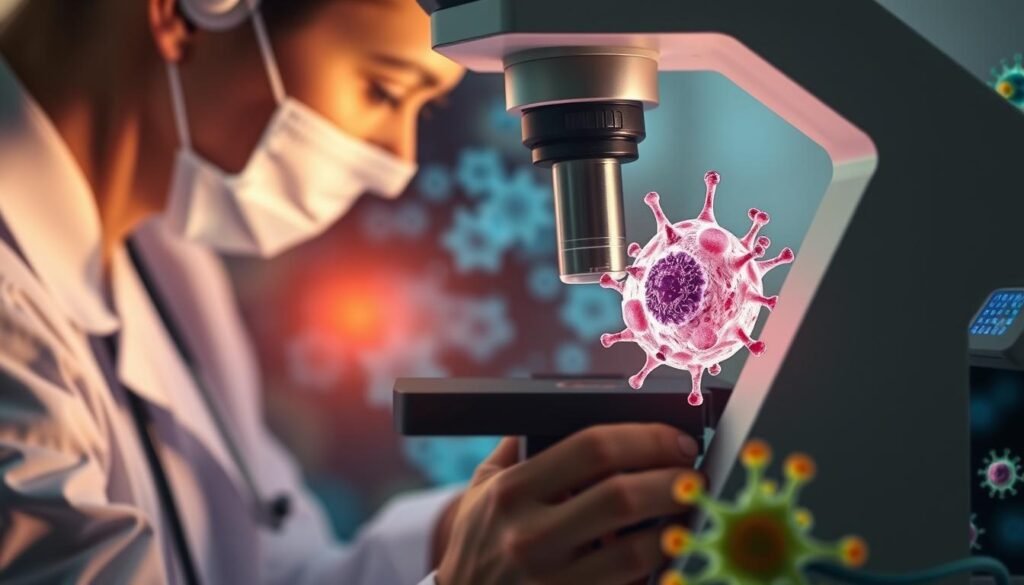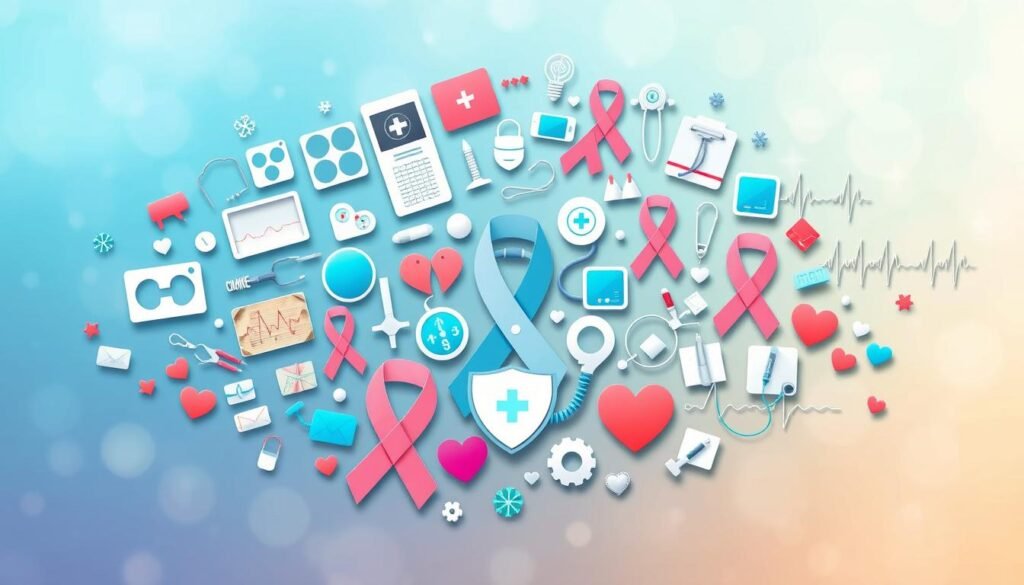Every year, about 8.8 million people die from cancer worldwide. Many of these deaths are in poorer countries. The need for early diagnosis to improve survival chances is very important. Finding cancer early can greatly increase the chances for successful treatment. This can save many lives. Late diagnosis often means lower survival rates and more complications.
This article discusses the vital role of early diagnosis in cancer care. Identifying cancer early leads to faster treatment and better health outcomes. The World Health Organization stresses the need for guidelines. These help with early cancer detection, especially where there are few diagnostic tools. Sadly, fewer than 30% of low-income countries have cancer diagnosis and treatment services. This shows a need for more global health initiatives for early detection.
By 2030, over 21 million people a year may be diagnosed with cancer. It’s crucial to focus on early detection now. Health providers, patient education, and good screening can help fight this disease. For more info, check out studies on early diagnosis in general and on COPD and lung cancer to learn about early treatment importance.
Key Takeaways
- Early diagnosis is crucial for enhancing survival rates in cancer patients.
- Timely intervention can lead to more favorable treatment outcomes.
- Only a fraction of low-income countries have accessible cancer diagnosis services.
- Education and awareness are key in promoting early detection among patients.
- Screening programs can significantly reduce late-stage cancer diagnoses.
The Critical Role of Early Diagnosis in Cancer Treatment
Finding cancer early is key to fighting it. It helps doctors start treatment sooner, which can stop the disease from getting worse. This early action can make care less intense and improve the journey through treatment.
How soon cancer is found can make a big difference in survival rates. For example, the one-year survival rate for early-stage prostate cancer is almost 100%. But at stage 4, it drops to 87.6%. For colorectal cancer, early detection means a 97.7% chance of surviving a year. This drops to 43.9% at stage 4. These numbers show why finding cancer early is so important for effective treatment and a better life after.
It’s crucial for healthcare to focus on finding cancer early. Right now, about half of lung cancers are found too late. Since cancer is a leading cause of death in the U.S., better early detection can save more lives and improve outcomes.
| Cancer Type | 1-Year Survival Rate at Stage 1 | 1-Year Survival Rate at Stage 4 |
|---|---|---|
| Prostate Cancer | ~100% | 87.6% |
| Hodgkin Lymphoma | 86.7% | 85.0% |
| Colorectal Cancer | 97.7% | 43.9% |
| Lung Cancer | 87.3% | 18.7% |
| Liver Cancer | 69.1% (Stage 2) | 39.3% (Stage 3) |
By getting better at diagnosing cancer early, we can help more people start treatment when it can help the most. Investing in early detection can increase survivors who live more than five years after finding their cancer.
Understanding Early Detection and its Impact on Prognosis
Early detection is key to fighting cancer. It improves the chance of beating cancer and helps patients do better overall. When cancer is found early, doctors can start treatment sooner. This is life-saving.
In breast cancer, finding it early can mean a 99 percent chance of living five more years. But if found late, that chance drops to 31 percent. Early detection makes a big difference.
Early detection also makes treatment simpler. It means less severe side effects for patients. Compared to late-stage treatments, early ones are often easier to handle. Late stages may require tough chemotherapies with hard side effects.
For colorectal cancer caught early, the survival rate is 91 percent. But for advanced cases, it falls to 13 percent. Regular checks, like CT scans for lung cancer, can lead to an 81 percent survival rate after 20 years. These numbers show how critical early cancer detection is.
Finding cancer early also costs less. Treatments for early-stage cancers are usually cheaper. This is because they are more likely to cure the cancer with less treatment. Late-stage cancers need more complex treatments, which costs more.

Early diagnosis helps with mental health, too. Knowing you have early-stage cancer is easier than facing advanced cancer. Doctors learning to spot early signs is crucial. Quick action can prevent cancer from getting worse.
Early detection changes the fight against cancer for the better. It leads to easier treatments, less cost, and better mental health. Understanding this helps healthcare systems aim for better survival rates and life quality.
Importance of Early Diagnosis for Improving Survival Outcomes
Finding cancer early is key to better survival chances. Many studies show that early cancer discovery boosts survival rates a lot. People who find out they have cancer early on live longer than those who find out later. This shows that knowing you have cancer early can really change how well treatment works.
Statistical Evidence Supporting Early Diagnosis
About 6-7% of deaths from cancer could be avoided by finding the disease early. For example, early-stage breast cancer patients have a survival rate between 83% and 96%. This is much higher compared to 10% to 39% for those found later. Research shows early detection saves lives and could cut cancer treatment costs by $26 billion a year in the U.S.
Comparison of Survival Rates by Stage at Diagnosis
The difference in survival rates between early and late diagnosis of cancer is stark. See below for survival rates of some common cancers, showing early detection benefits:
| Cancer Type | Survival Rate (Early Stage) | Survival Rate (Advanced Stage) |
|---|---|---|
| Breast Cancer | 83% – 96% | 10% – 39% |
| Cervical Cancer | 93% | 15% |
| Colorectal Cancer | 90%+ | 14% |
| Pancreatic Cancer | 20% – 30% | 3% – 4% |
Being diagnosed late with cancer increases death rates and puts more stress on health services. Early detection means people live longer and it costs less money. So, it’s clear we need better screening and diagnosis programs.

Cancer Screening: A Distinct Strategy for Prevention
Cancer screening is key in preventing disease. It spots people who might get cancer, even if they feel fine now. By finding cancer early, screening can save lives and improve health. It includes various tests that let people take control of their well-being.
Overview of Effective Screening Programs
Great cancer screening programs focus on certain cancers:
- Breast cancer: Getting mammograms regularly aids in catching it early. This greatly lessens the death rate among women.
- Cervical cancer: The Pap test and HPV vaccines have helped reduce both sickness and death rates.
- Colorectal cancer: Screening options like colonoscopies can find early signs, leading to fewer serious cancer cases.
Screening does more than find cancers early. It also keeps an eye on risk factors. A trusted test gives consistent and accurate results. It’s also sensitive and specific. The results help doctors understand how well the test works.
WHO Recommendations for Cancer Screening
The WHO sets clear guidelines for screening. It says screening should start when it’s known to work well. There must be enough support for any needed follow-up treatments. Nations should use the WHO’s advice to make strong cancer screening plans. This boosts the power of preventive care.

Challenges in Implementing Early Diagnosis Initiatives
Walking the path towards effective early diagnosis is tough. The benefits of catching diseases early are obvious. Yet, real obstacles within healthcare systems make it hard. Limited resources and not enough advanced tools are big problems. These make it hard for healthcare workers to start strong early diagnosis programs.
Barriers Faced by Healthcare Providers
Healthcare workers face key challenges in starting early diagnosis efforts, such as:
- Resource limitations: Many places, especially in poorer countries, don’t have the needed equipment or trained staff.
- Access to diagnostic tools: Patients in these places often can’t get the tests they need because they’re too expensive or not available.
- Time constraints: Busy medical places might focus more on immediate care, leaving little room for preventive steps.
These challenges hit harder in poorer or rural areas. It’s crucial to work together well to get past these obstacles.
Public Awareness and Patient Education Gaps
A huge hurdle is also improving how much the public knows and educating patients better. For early diagnosis to work best, patients need to know when to see a doctor. Not knowing the signs of illnesses or why early checks are key stops many from getting help fast. Boosting public info campaigns and better education on health can make a big difference in catching diseases early.
Health organizations should focus on:
- Starting education campaigns aimed at people at higher risk.
- Sharing info on early warning signs and how to prevent illnesses.
- Making interactive tools that help patients take charge of their health.
To see better success in early diagnosis, these gaps in public knowledge need to be filled. You can learn more about these challenges here.
| Barriers | Impacts on Early Diagnosis |
|---|---|
| Resource limitations | Reduced access to necessary tests and treatment options |
| Access to diagnostic tools | Delayed diagnoses and poorer patient outcomes |
| Public awareness gaps | Lower rates of early-stage detection |
| Patient education | Lack of symptom recognition leads to late-stage diagnosis |
Case Studies: Successful Early Diagnosis Programs
Looking at successful early diagnosis programs helps us see how special plans can make patients’ lives better. The United States has set up programs that really show how spotting diseases early can save lives and money.
Examples from the United States
The National Awareness and Early Diagnosis Initiative works to improve how we deal with cancer countrywide. It has made more people aware of early screening and diagnosis. This leads to better patient results. There are many success stories from this program:
- In the case of colorectal cancer, the program has noticed a big difference in early diagnosis rates in different areas. This shows we need specific plans for each region.
- For lung cancer, there’s also a big difference in how early it’s found. This tells us that there’s room for the U.S. to get better at finding it early.
- With ovarian cancer, the variation in early diagnosis is even bigger. This highlights how important it is to have programs that encourage people to get checked early.
International Success Stories in Early Diagnosis
Countries like Denmark have also done great work in finding diseases early. They’ve put in place broad plans that focus on early detection:
- Such plans have saved a lot of money. For example, over £24 million was saved in treating colon cancer. This directly helped more than 4,500 patients.
- Programs for rectal cancer saved nearly £10 million. Similarly, ovarian cancer initiatives saved over £16 million. This shows the double benefit of getting healthier and saving money.
- Also, these plans have led to better survival rates. For example, more than 5,000 extra patients might survive five years after their diagnosis with better early diagnosis strategies.
Role of General Practitioners in Early Diagnosis
General practitioners (GPs) are key to finding cancer early. Their training is crucial for spotting symptoms soon. Better training means they’re more alert to cancer signs, helping catch the disease early.
How GP Training Can Influence Diagnosis Rates
Advanced training helps GPs identify possible cancer signs quickly. They learn about various symptoms, risk factors, and follow-up’s importance. This education boosts diagnosis rates and early referrals for more tests or specialist care.
Access to Diagnostic Tests and Timely Referrals
GPs need access to a wide range of tests to diagnose properly. Sometimes, not having enough tests can delay finding the problem. Making referrals faster for more tests helps GPs address cancer quickly.
Studies show that patient issues can also cause delays. But, GPs’ know-how, testing tools, and quick referrals can improve chances of survival. For deeper understanding, check out studies on the role of general practitioners in catching cancer early.
Emerging Technologies in Diagnostic Tests
New technologies are changing how doctors test for cancer. They’re making tests faster, more accurate, and trustworthy. This means doctors can find cancer sooner, which can greatly help patients.
Advancements in Imaging and Biomarker Discovery
Doctors now have better tools like MRI and CT scans to spot cancer early. These tools are very precise. They help in checking for cancer, understanding its stage, and seeing if it’s growing. Also, doctors are finding more biomarkers. These give detailed info about the cancer at the cell level. This helps doctors create the best treatment plans.
The Future of Tumor-Derived Exosome Detection
Exosome detection is a new, promising area in cancer tests. These exosomes carry important details about the cancer. As research improves, these tests will give deeper insights into how cancers operate. They could change how early cancer is found, leading to better care for patients.
Conclusion
Finding cancer early is key to saving lives. Programs like the National Awareness and Early Diagnosis Initiative (NAEDI) help a lot. They have worked hard since they started to catch cancer early. Campaigns such as ‘Be Clear on Cancer’ and ‘Detect Cancer Earlier’ are crucial. They teach people about cancer signs. This means people go to the doctor sooner.
Screening programs and doctor education are very important. Doctors need to know the early signs of cancer to help patients fast. It’s also vital to have enough resources and easy access to diagnosis services. We must remove barriers in the healthcare system.
To sum up, making early diagnosis a priority helps improve cancer treatment results. Focusing on early intervention is key for better patient care and survival rates. It’s an important area for future improvements in cancer care.